Distances
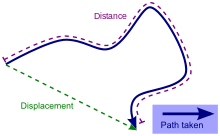
"Distance (or farness) is a numerical description of how far apart objects are. In physics or everyday discussion, distance may refer to a physical length, or an estimation based on other criteria (e.g. "two counties over"). In mathematics, a distance function or metric is a generalization of the concept of physical distance. A metric is a function that behaves according to a specific set of rules, and provides a concrete way of describing what it means for elements of some space to be "close to" or "far away from" each other."[1]
Notations
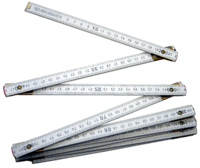
Def. a "basic unit of length in the International System of Units (SI: Système International d'Unités)"[2] is called a metre, or meter.
Notation: let m represent a metre.
Notation: let km represent a kilometre.
Measurements

Def. a usually rigid "flat, rectangular measuring or drawing device with graduations in units of measurement; a rule; a straightedge with markings; a measure"[3] is called a ruler.
"Measurement is the process or the result of determining the ratio of a physical quantity, such as a length, time, temperature etc., to a unit of measurement, such as the meter, second or degree Celsius."[4]
For measuring distances around that of a kilometre, a measuring wheel or surveyor's wheel as in the second image down on the right may be used.
Standards
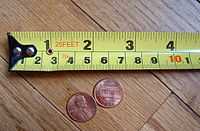
.jpg)
Def. a "principle or example or measure used for comparison"[5] is called a standard.
While a US penny may be rather precisely made and somewhat familiar, it is usually not considered a standard for length or size yet at slightly smaller scales suffices.
The public meter standard by Chalgrin in the second image down on the right is from the 18th century (36, rue de Vaugirard, 6th arrondissement of Paris, near the Luxembourg Palace). The public could bring meter rulers and check if they were accurate. A bar that just fit between the end stops was exactly one meter.
Astronomy
Notation: an astronomical unit is usually represented by au, or AU.
Def. an "SI unit of length equal to 103 metres"[6] is called a kilometre, or kilometer.
Def. "a conventional unit of length equal to 149 597 870 700 m exactly"[7] is called an astronomical unit (au).
Def. "9,460,730,472,580.8 km" is called the light-year (ly).[7]
Radiation
Def. a "vector quantity which denotes distance with a directional component"[8] is called a displacement.
Radiation is usually thought of as projected from a source to a point or set of points at a distance from the source. Its displacement is the direction and distance from its source.
Theoretical distances
Def. an "amount of space between two points, usually geographical points, usually (but not necessarily) measured along a straight line"[9] is called a distance.
Materials
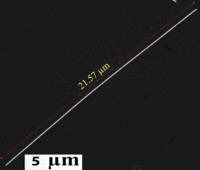
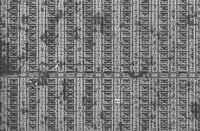
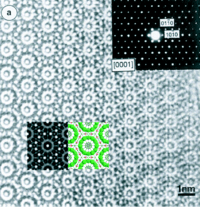


Def. a unit "of length; the thousandth part of one millimeter; the millionth part of a meter"[10] is called a micron.
"As one spacecraft lurches and drags through the Earth's uneven gravity field, the second follows 210 km behind, measuring changes in their separation to the nearest micron (a thousandth of a millimetre)."[11]
Def. an "SI subunit of length equal to 10-9 metres"[12] is called a nanometre.
The second image down on the right is an integrated circuit die image of a STM32F103VGT6 ARM Cortex-M3 MCU (microcontroller) with 1 Mbyte Flash, 72 MHz CPU, motor control, USB and CAN. Die size is 5339x5188 µm. View is from a Scanning Electron Microscope looking at the 180 nanometre SRAM cells on the die.
The third image down on the right is a high-resolution, transmission electron micrograph (HRTEM) lattice image with an electron diffraction pattern (top-right inset) taken along the [0001] direction; i.e., looking down the [0001] axis. An image simulation is added in the bottom-left inset, and a model fragment of the crystal structure is on the right of the bottom-left inset. On the lower right of the composite image is a 1 nanometre (nm) marker.
Def. "10-12 of a metre"[13] is called a picometre.
The fourth lower image down on the right has an image of 1,750 x 810 pm.[14]
It is an atomic force microscope image of stacked graphene sheets in graphite.[14]
This compares with the image on the left which was taken at a height of ~97 pm above the surface.[14]
The image on the lowest right was at ~12 pm.[14]
For most heights above the surface the features display a three-fold symmetry as on the right.[14]
Mathematics
Def.
- "a quantity that has both magnitude and direction"[15]
- "the signed difference between two points"[16] or
- an "ordered tuple representing a directed quantity or the signed difference between two points"[16]
is called a vector.
See also
References
- ↑ "Distance, In: Wikipedia". San Francisco, California: Wikimedia Foundation, Inc. June 2, 2012. Retrieved 2012-06-16.
- ↑ "metre, In: Wiktionary". San Francisco, California: Wikimedia Foundation, Inc. 24 July 2015. Retrieved 2015-08-10.
- ↑ "ruler, In: Wiktionary". San Francisco, California: Wikimedia Foundation, Inc. 24 July 2015. Retrieved 2015-08-10.
- ↑ "Measurement, In: Wikipedia". San Francisco, California: Wikimedia Foundation, Inc. June 14, 2012. Retrieved 2012-06-16.
- ↑ "standard, In: Wiktionary". San Francisco, California: Wikimedia Foundation, Inc. 30 July 2015. Retrieved 2015-08-10.
- ↑ "kilometre, In: Wiktionary". San Francisco, California: Wikimedia Foundation, Inc. 24 July 2015. Retrieved 2015-08-10.
- 1 2 P. K. Seidelmann (1992). "Measuring the Universe, The IAU and astronomical units". International Astronomical Union. Retrieved 2015-08-09.
- ↑ 68.147.32.114 (24 November 2006). "displacement, In: Wiktionary". San Francisco, California: Wikimedia Foundation, Inc. Retrieved 2015-08-10.
- ↑ "distance, In: Wiktionary". San Francisco, California: Wikimedia Foundation, Inc. 17 April 2015. Retrieved 2015-05-11.
- ↑ Poccil (8 August 2015). "micron, In: Wiktionary". San Francisco, California: Wikimedia Foundation, Inc. Retrieved 2015-08-10.
- ↑ Jonathan Amos (2009). "Satellites weigh California water". BBC. Retrieved 2015-08-10.
- ↑ Paul G (29 June 2005). "nanometre, In: Wiktionary". San Francisco, California: Wikimedia Foundation, Inc. Retrieved 2015-08-10.
- ↑ Merope~enwiktionary (3 October 2006). "picometre, In: Wiktionary". San Francisco, California: Wikimedia Foundation, Inc. Retrieved 2015-08-10.
- 1 2 3 4 5 Boris J. Albers, Todd C. Schwendemann, Mehmet Z. Baykara, Nicolas Pilet, Marcus Liebmann, Eric I. Altman and Udo D. Schwarz (May 2009). "Three-dimensional imaging of short-range chemical forces with picometre resolution". Nature Nanotechnology 4: 307-10. doi:10.1038/NNANO.2009.57. http://web.pdx.edu/~larosaa/RESEARCH_GROUP_Current_assignment/2009_3D%20imaging%20of%20short%20range%20chemical%20forces%20with%20picometer%20resolution.pdf. Retrieved 2015-08-10.
- ↑ Paul G (22 December 2003). "vector, In: Wiktionary". San Francisco, California: Wikimedia Foundation, Inc. Retrieved 2015-08-10.
- 1 2 "vector, In: Wiktionary". San Francisco, California: Wikimedia Foundation, Inc. 24 July 2015. Retrieved 2015-08-10.
External links
| ||||||||||||||||||||||||||||||||||||||
![]() This is a research project at http://en.wikiversity.org
This is a research project at http://en.wikiversity.org
| |
Development status: this resource is experimental in nature. |
| |
Educational level: this is a research resource. |
| |
Resource type: this resource is an article. |
| |
Resource type: this resource contains a lecture or lecture notes. |
| |
Subject classification: this is an astronomy resource. |
| |
Subject classification: this is a Geology resource. |
| |
Subject classification: this is a physics resource . |